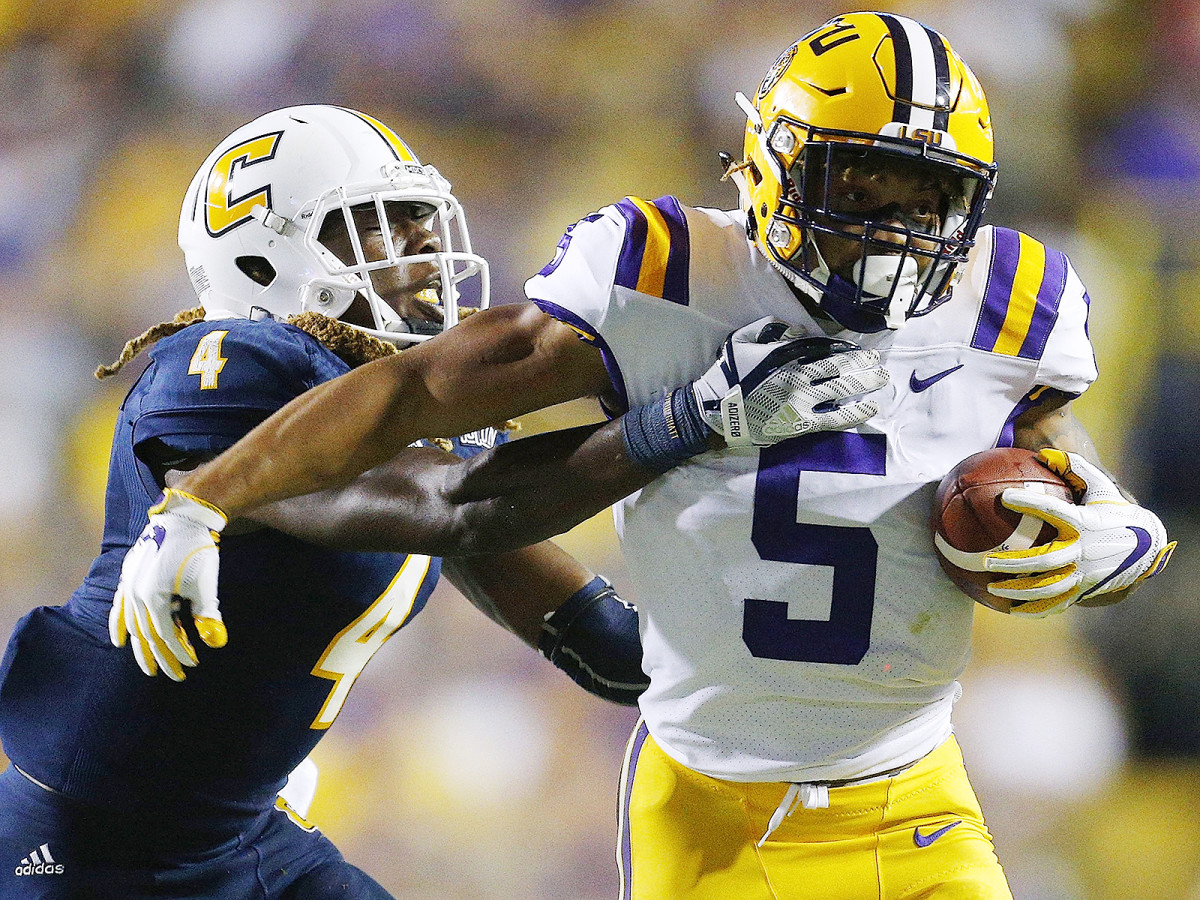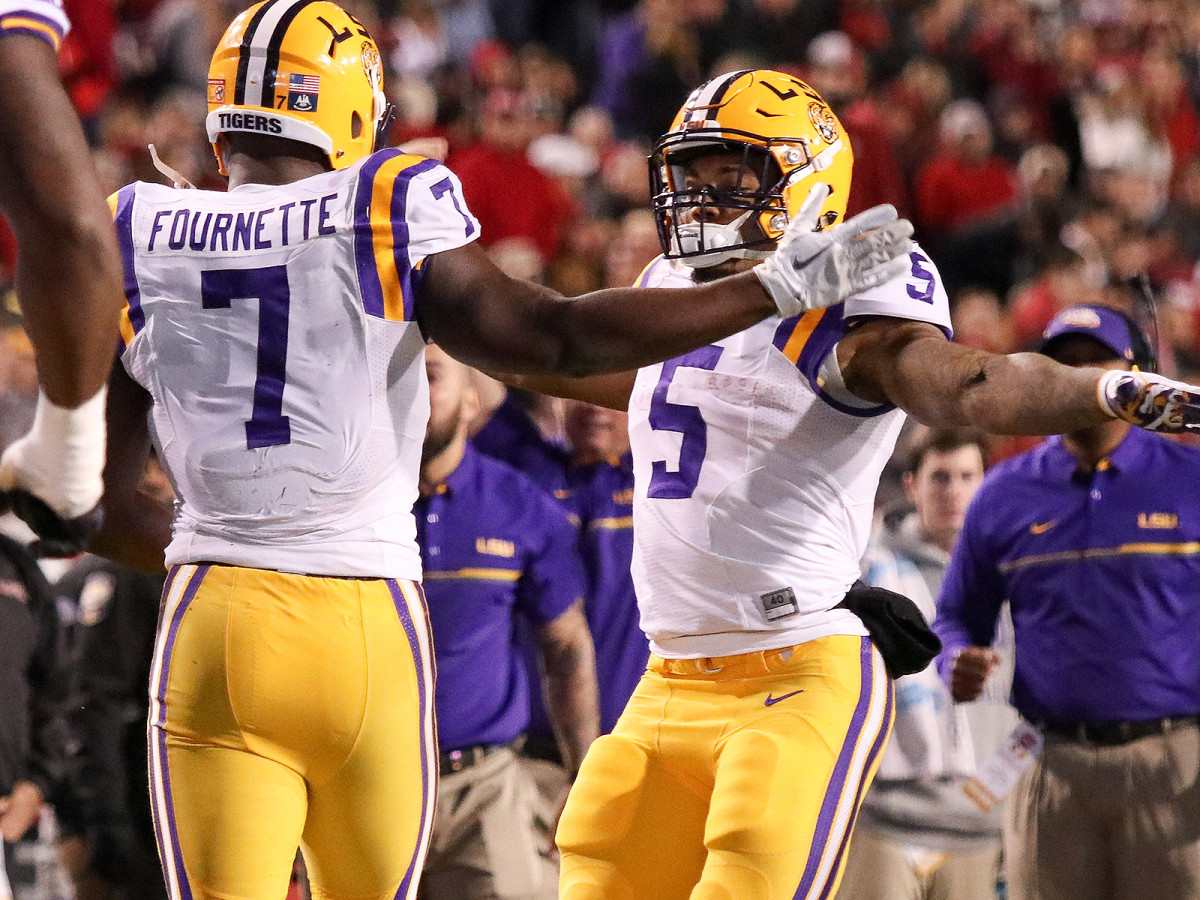In LSU's New Offense, Derrius Guice Is the Same Old Superstar Running Back

When LSU hired Matt Canada last December, it banked on the former Pittsburgh coordinator to add flair and versatility to an offense that had gone stale by the end of Les Miles’s tenure in Baton Rouge. Miles’s offense became predictable, too reliant on a talented running back and play-action passes. In bringing Canada aboard, the Tigers hoped to finally capitalize on the immense talent they recruit each year at the skill positions.
From a glance at LSU’s box scores through two games, it’s hard to tell how much has changed. Sure, the Tigers are scoring more (27 points in a shutout of BYU and 45 in a rout of Chattanooga on Saturday) but the ways they’re scoring are familiar—a few passes but mostly runs—and as was the case in Miles’s system, the team’s best backs are getting plenty of touches.
That will change. In those two easy wins, there was little incentive for Canada to reveal any answers to one of the college football offseason’s biggest questions: How would the Tigers revamp an attack that ran hot and cold in recent years? LSU has kept things simple in the early going—after Week 1, coach Ed Orgeron said Canada used about 10% of his call sheet—because that’s more than enough against lesser opponents. And the longer everyone spends wondering what Canada’s chalkboard-sized call sheet might contain, the less time they have to focus on the part of LSU’s attack that is no mystery: a phenomenal running game spearheaded by one of the best backs in the country. Whatever form the new offense takes once the meat of the schedule hits, starting with Saturday’s road trip to Mississippi State, expect Derrius Guice to be at the center of it.

A long Guice run—like the 70-yarder that broke things open in LSU’s Citrus Bowl win over Louisville, or the 96-yard touchdown run he popped against Arkansas—looks like it’s unfolding in fast-forward. Guice’s free arm pumps as fast as his legs churn, chewing up yards at an almost incredible rate. He started where? And he’s already in the end zone?
“When he hits the hole, it’s different, compared to anyone else,” offensive lineman Will Clapp says. “You see a little blur that runs through the hole, and the next thing I know, there’s somebody running downfield, and I just try to catch up, hopefully, for a touchdown.”
Guice started 2016 as Leonard Fournette’s backup and ended it as the SEC’s leading running back in total yardage (1,387), yards per carry (7.6) and rushing touchdowns (15). He scored the Tigers’ first two touchdowns of the 2017 season against BYU, carrying the ball 27 times for 122 yards against the Cougars in just three quarters of action, then added two more touchdowns against Chattanooga before being sidelined one series into the second half. That abbreviated night still got him above 2,000 rushing yards for his career and extended his streak to four straight games with at least 100 rushing yards, dating back to a 285-yard performance against Texas A&M in November that encouraged Tigers fans that the post-Fournette world in Baton Rouge would be, well, just fine.
Mike Stoops Explains the Defensive Turnaround That Helped Oklahoma Take Down Ohio State
“He can do it all now,” says Fournette, the No. 4 pick in the 2017 draft. “He can run, catch, block. He does it all in a game, whenever you need him: fourth-and-one, when you need him to catch the ball a couple inches down the field. He’s there. He’s one of the most exciting players to be in college football right now. I believe he has the ability to be the No. 1, No. 2—even [higher than] me—player coming out of the draft.”
“Most young running backs, they just think about taking a handoff and running,” says Dale Weiner, Guice’s coach at Catholic High School in Baton Rouge. Guice understood he needed to catch passes and sell play-action, too. When he arrived at LSU in 2015, the biggest hole in his game was in pass blocking, but after just a few months, teammates and coaches noticed a pronounced difference in his physicality at the line of scrimmage, according to the star running back in whose shadow Guice adjusted to college ball.
Clapp calls both players “all-world running backs,” though their styles differ: Fournette’s game was driven by physicality; Guice runs with what receiver Drake Davis describes as “controlled anger.”
Teammates attribute that energetic but intense force to Guice’s childhood in Baton Rouge. His father was murdered when he was six, and just last year, Guice’s brother Derrick was arrested and charged with attempted murder, among other crimes. He has done his best during his time at LSU to move on from that instability while still honoring the place where he’s lived his whole life, but he still guards those around him; after receiving word that SI had called several people with whom he was close in high school, he objected and subsequently did not make himself available for an interview. Still, plenty of people who have crossed paths with Guice over the years were quick to laud the man—and player—he has become. The anger that marks his game, teammates are quick to point out, he channels into productivity.
“There’s always a thought behind his moves,” Davis says. “You think he’s running reckless, but there’s always a thought behind it.”
In Its Search for Answers on Offense, Ohio State Should Explore Options Beyond J.T. Barrett
And there always has been. “The plays that he’s making in college, that everybody knows him [for] now—we saw those types of plays when he was in the ninth grade, throwing caution to the wind, bouncing off of people, pulling away,” Weiner explains. “You can’t wrap him up. It’s just one of those things where you think you’ve got your hands on him, and he’s twisting and turning and bouncing and all this kind of stuff.
“Some kids, they can’t turn the bad play into a good one. If you block everybody, they’ll run through it, and [that’s] that. He made those bad plays into good ones—often.”

LSU left tackle K.J. Malone’s belief that Guice could fit into any offense bodes well for the Tigers as Canada opens up their attack. If Canada’s unit from his lone year at Pitt is anything to base expectations off of, there will be plenty of shovel passes, end-around jet sweeps and option looks. The scheme kept opponents guessing even when they had months to game-plan for it.
And while it’s tempting to build an offense around a player of Guice’s caliber, LSU knows it has to have more options lest it run its star back into the ground by midseason. No longer are the Tigers the program that attracted Guice because of Miles’s reliance on the running game and willingness to get his lead backs a ton of carries; instead, it will be a more balanced attack. That level of unpredictability plus Guice’s knack for breaking tackles and outrunning even the speediest defenders could be a lethal combination.
Guice’s physicality has been on display early this season, but his versatility and ability to break off big chunks of yardage has been absent—his longest run of the year so far is just 25 yards. That won’t last. Even as LSU’s offense keeps opponents guessing, Guice will not. By now, his churning legs are a known quantity, though that makes him no less terrifying to opponents trying—and often failing—to stop him.
